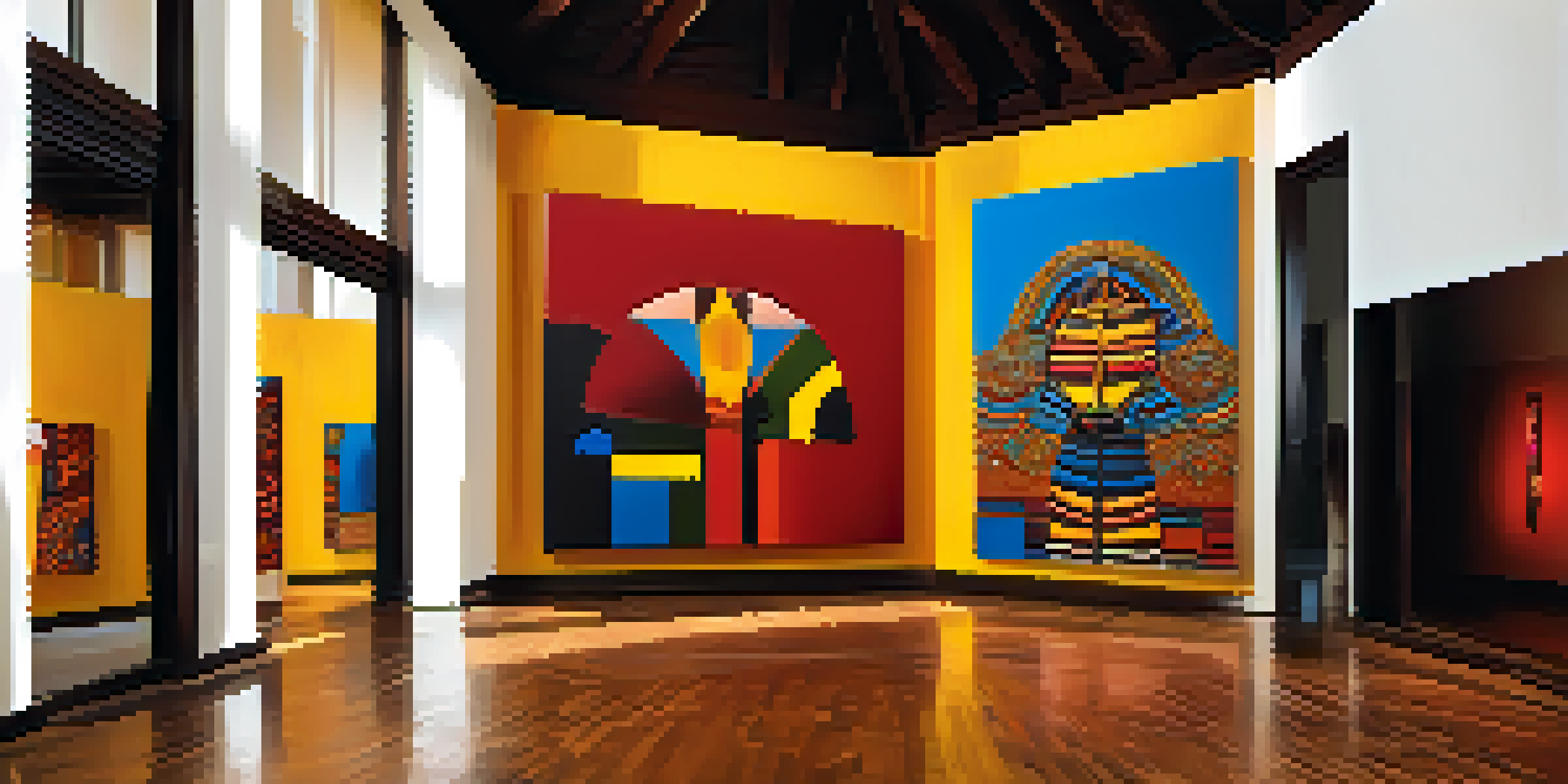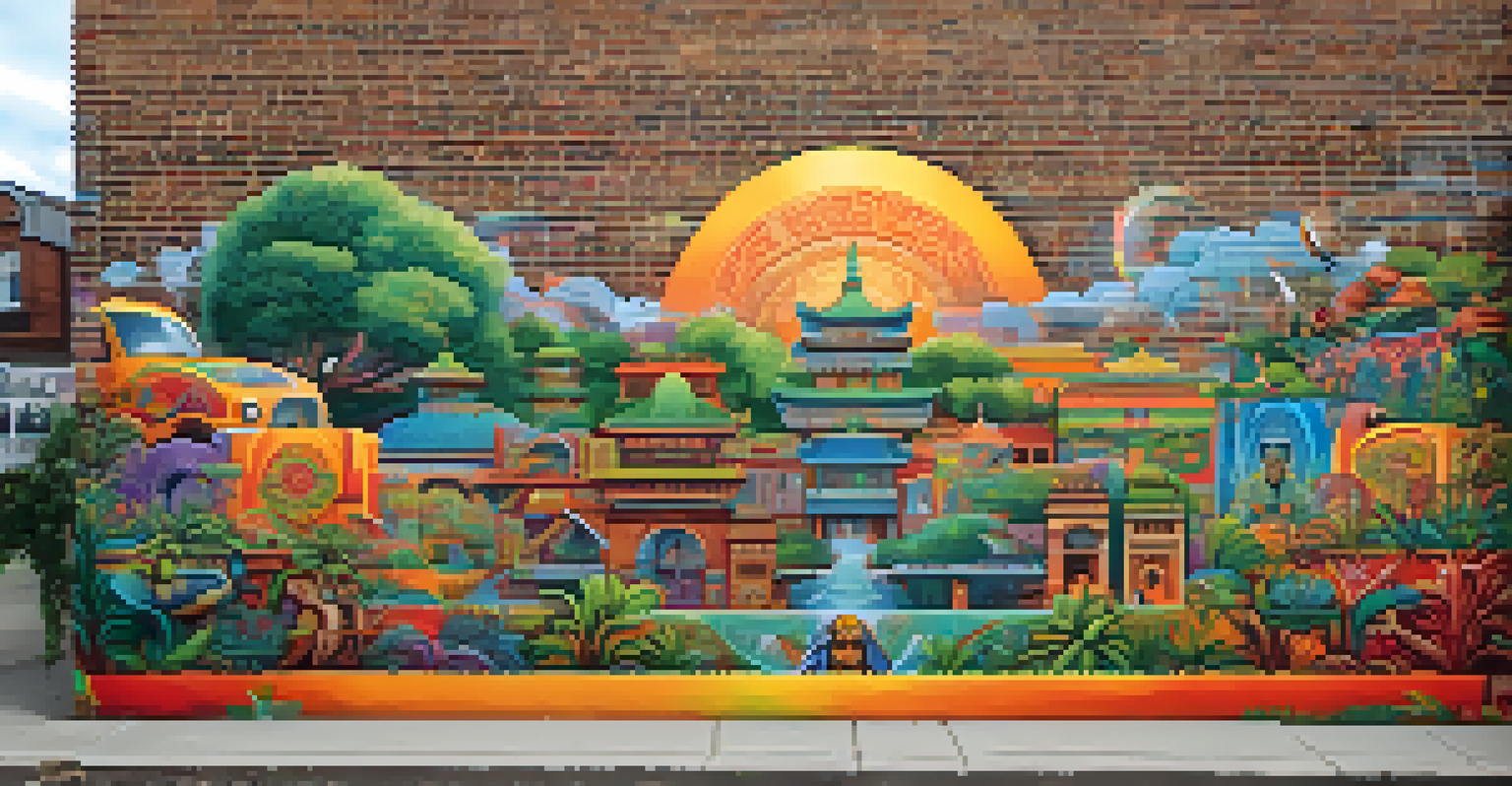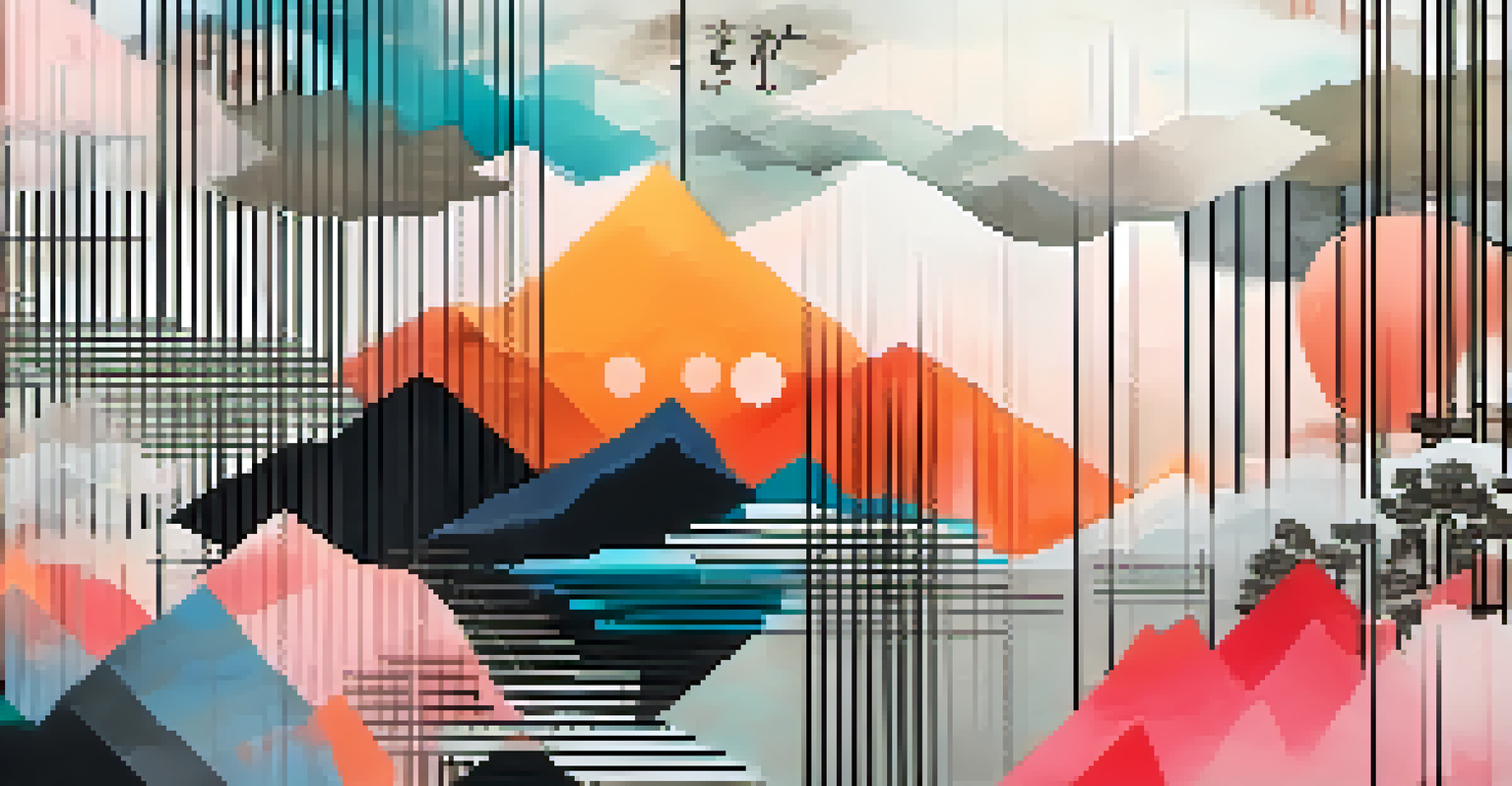Cultural Fusion in Modern Painting: A Global Overview

Understanding Cultural Fusion in Modern Art
Cultural fusion in modern painting refers to the blending of different artistic traditions, techniques, and themes from around the world. It reflects a growing interconnectedness in today’s society, where artists draw inspiration from diverse cultures. This fusion allows for a richer dialogue and deeper understanding of global narratives, making art more relatable and dynamic.
Art is the most beautiful of all lies.
For instance, an artist might combine traditional African motifs with contemporary Western styles, creating a piece that speaks to both heritage and modernity. This cross-pollination of ideas not only challenges conventional boundaries but also invites viewers to engage with the art on multiple levels. In essence, cultural fusion showcases the beauty of diversity and the power of collaboration.
Moreover, this blending of cultures often results in innovative techniques and fresh perspectives. By embracing influences from various backgrounds, artists can create visually stunning works that resonate with a broad audience. As we delve deeper into this global phenomenon, we uncover how past and present, tradition and innovation intertwine in the realm of modern painting.
Historical Roots of Cultural Fusion in Art
The roots of cultural fusion in art can be traced back centuries, where trade routes and migration brought different cultures into contact. Historical events like the Silk Road facilitated not only the exchange of goods but also artistic ideas and styles. This early interaction laid the groundwork for the rich tapestry of artistic expression we see today.

For example, during the Renaissance, artists in Europe were influenced by Middle Eastern and Asian art through trade and exploration. This resulted in a fusion of techniques, such as the use of perspective and intricate patterns, that transformed Western art. Such historical instances remind us that cultural exchange is not a new phenomenon; it has always played a pivotal role in shaping artistic landscapes.
Cultural Fusion Enriches Art
The blending of diverse artistic traditions enhances modern painting, fostering deeper understanding and dialogue around global narratives.
As we explore modern painting, it’s essential to recognize how these historical influences continue to echo in contemporary works. By understanding the origins of cultural fusion, we can better appreciate the complexity and depth of current artistic expressions. This history serves as a reminder that art is a living dialogue, continuously evolving through shared experiences.
Contemporary Artists Embracing Cultural Fusion
Today, many contemporary artists actively embrace cultural fusion, using their platforms to explore identity, heritage, and belonging. Artists like Yinka Shonibare and Ai Weiwei blend their cultural backgrounds with modern themes, creating thought-provoking works that challenge societal norms. Their art often serves as a commentary on globalization and its impact on personal and collective identities.
Creativity is the power to connect the seemingly unconnected.
For instance, Shonibare’s use of Dutch wax fabric in his sculptures reflects the complexities of colonial history while celebrating African culture. Similarly, Weiwei incorporates traditional Chinese art forms into his installations, fostering a discussion on freedom and expression in the face of authority. These artists exemplify how cultural fusion can be a powerful tool for storytelling and advocacy.
Moreover, their works invite viewers to reconsider preconceived notions of culture and identity. By intertwining various influences, these artists create a dialogue that resonates across borders and generations. This approach not only enriches their art but also encourages audiences to engage with the themes of hybrid identities and shared experiences.
The Role of Technology in Cultural Fusion
In our digital age, technology plays a crucial role in facilitating cultural fusion in modern painting. Social media platforms and online galleries allow artists to share their work with a global audience, breaking down geographical barriers. This accessibility fosters collaboration and exchange, enabling artists from different backgrounds to inspire one another.
For example, virtual art communities provide spaces where artists can showcase their fusion works and connect with like-minded individuals. These interactions often lead to new artistic collaborations, resulting in innovative projects that blend diverse influences. As artists share their processes online, they also invite viewers into their creative journeys, making art more inclusive and participatory.
Tech Drives Artistic Collaboration
Advancements in technology and social media facilitate cultural fusion by allowing artists to connect and share their work globally.
Additionally, digital tools allow for experimentation with different styles and mediums, further enriching the fusion process. Artists can easily blend traditional techniques with digital art, creating unique pieces that reflect a modern sensibility. As technology continues to evolve, so too will the ways in which cultural fusion manifests in the art world.
Cultural Fusion and Globalization in Art
Globalization has significantly impacted the landscape of modern painting, accelerating the process of cultural fusion. As artists from diverse backgrounds come into contact, they exchange ideas, techniques, and themes, leading to a vibrant artistic dialogue. This interconnectedness allows for a more profound exploration of identity and culture in contemporary art.
One notable example is the rise of street art, which often incorporates elements from various cultures to address global issues. Artists like Banksy and Shepard Fairey blend political commentary with diverse visual styles, creating works that resonate with audiences worldwide. Their art transcends cultural boundaries, highlighting shared experiences and challenges faced by communities across the globe.
Furthermore, this globalization of art encourages a broader understanding of different cultures, fostering empathy and connection. By engaging with cultural fusion, viewers can appreciate the richness of diversity and the stories that shape our world. Ultimately, globalization serves as a catalyst for creativity, pushing the boundaries of artistic expression and enriching the global art scene.
Challenges of Cultural Fusion in Modern Painting
While cultural fusion in modern painting is celebrated, it also presents certain challenges that artists must navigate. One significant issue is the risk of cultural appropriation, where elements from one culture are used without understanding or respect for their significance. This can lead to misrepresentation and exploitation, sparking debate within the art community.
For instance, when artists adopt traditional symbols or techniques without acknowledging their origins, it can dilute the meaning behind those elements. This raises questions about authenticity and ownership in art. Artists must be mindful of their inspirations and strive for genuine engagement with the cultures they draw from to avoid these pitfalls.
Navigating Cultural Appropriation
While cultural fusion is celebrated, artists must be mindful of cultural appropriation to ensure respect and authenticity in their work.
Moreover, navigating these complexities requires a delicate balance between honoring traditions and pushing creative boundaries. Artists are encouraged to engage in dialogue with the cultures they represent, fostering mutual respect and understanding. By addressing these challenges, cultural fusion can evolve into a more thoughtful and enriching artistic practice.
The Future of Cultural Fusion in Painting
As we look ahead, the future of cultural fusion in painting appears vibrant and full of possibilities. With advancements in technology and increased global connectivity, artists are likely to continue exploring diverse influences in their work. This ongoing exchange of ideas will further enrich the artistic landscape, making it even more dynamic and inclusive.
Additionally, as societal conversations around identity and representation evolve, artists will increasingly use cultural fusion to address contemporary issues. Themes of migration, globalization, and social justice are likely to be woven into their narratives, creating art that not only reflects personal experiences but also resonates with broader societal concerns.

Ultimately, the future of cultural fusion in painting holds the promise of continued innovation and collaboration. By embracing diversity and fostering cross-cultural dialogue, artists can create works that inspire and challenge us to see the world through a multifaceted lens. As the art world evolves, so too will our understanding of culture, identity, and the power of creative expression.